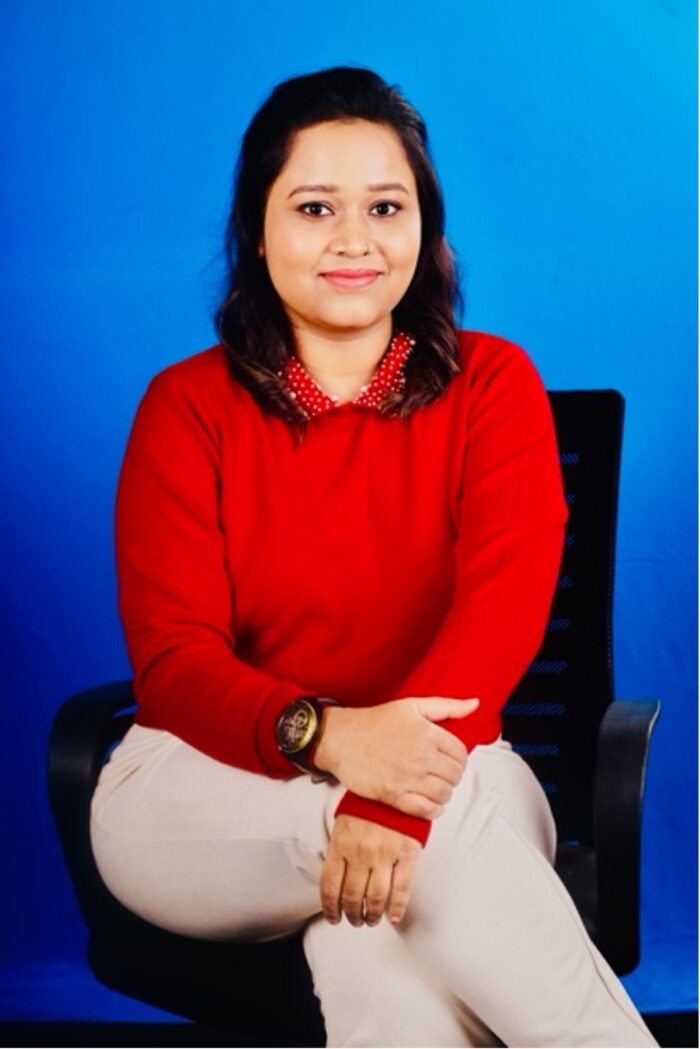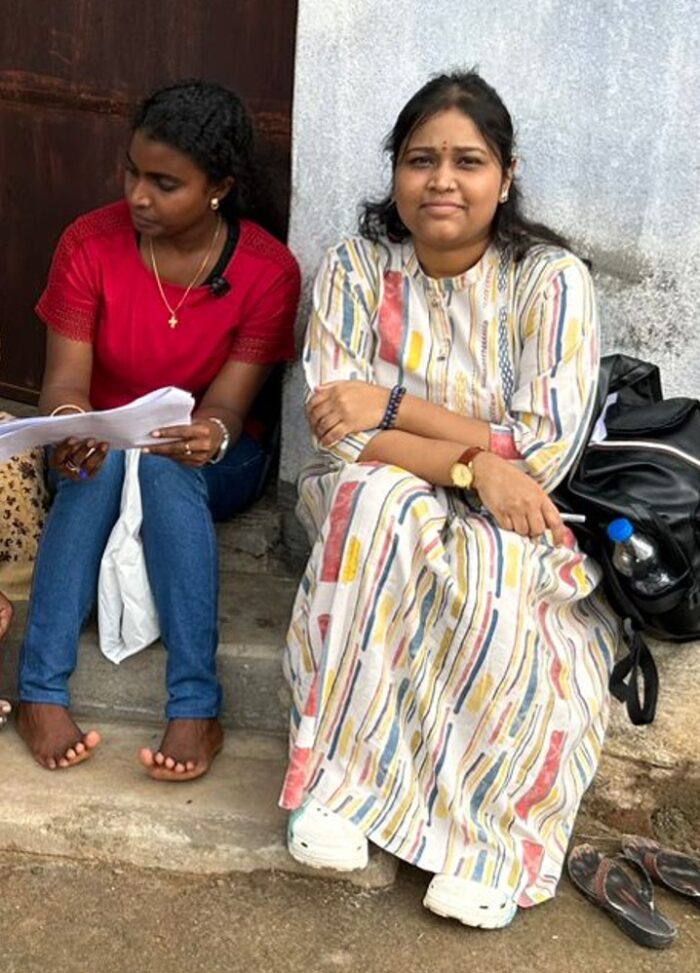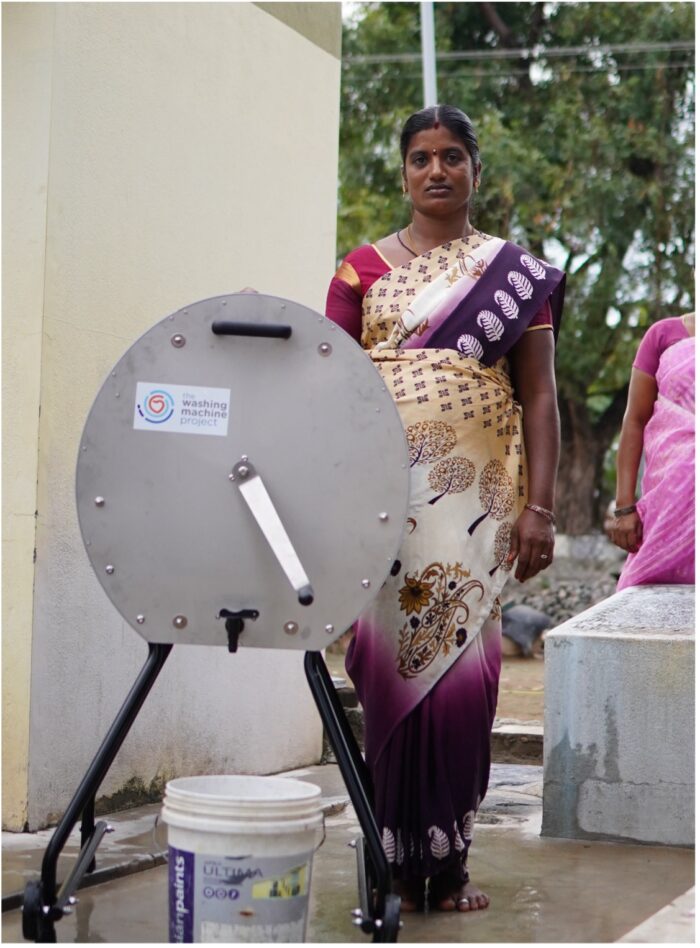Field Notes from Tamil Nadu: The Quiet Power of Blindfolding and an Outcomes Based approach
| 10 October 2025 | News
A guest blog written by psychotherapist and researcher Thenndral S, who was co-lead researcher on our recent evaluation of The Washing Machine Project in India.
Fieldwork often demands that we unlearn what we think we know about people, places, and even research itself. During my recent visit to four locations in Tamil Nadu, I had the opportunity to conduct QuIP (Qualitative Impact Protocol) data collection on behalf of Bath SDR. What made this experience remarkable wasn’t just the stories that emerged, but the natural, honest and nuanced way they came to the surface, thanks largely to two elements: blindfolding and outcomes-based interviewing.

The QuIP Way: Letting Narratives Lead
The QuIP method isn’t a typical questionnaire-driven data collection process. It is grounded in open-ended, qualitative interviews that invite respondents to reflect on changes in their lives over time and the reasons behind them without any cues about a specific intervention. Rather than asking “Did program X help you do Y?”, QuIP asks questions like, “Have there been any changes in how you earn a living over the past year? What led to those changes?”
This style of open-ended question lets the respondent guide the narrative. My role was not to lead respondents toward a particular answer but to follow their threads with gentle probing asking why or how something happened, and to listen to the connections and attributions they shared.
Blindfolding and an Outcomes Based Approach
One of the most distinctive features of QuIP is blindfolding. In this context, it means that we, the research team, and the respondents were told as little as possible about the project being evaluated during the data collection process. This had a profound impact on the interviews, inviting respondents to explore the full range of factors influencing change in their lives.
Many of the villages we visited had past interactions with an NGO and in several interviews, villagers assumed we were part of the same NGO. Some welcomed us warmly; others were visibly frustrated and had questions about the NGO’s activities.
However, once I clarified, “I’m not from the NGO, I’m an independent researcher.” their tone shifted. Those who had them still expressed concerns, but now more freely. Others relaxed, perhaps realising they didn’t have to say what they thought we wanted to hear.
That is the quiet power of blindfolding and an outcomes-based approach: it reduces incentive bias and performance pressure. It encourages respondents to share real experiences, not what they assume a funder or organisation might want to hear. For us as researchers, it creates a clearer, truer picture of what’s happening on the ground.
What It Looked Like in Practice
My first respondent was hesitant but polite. She was in the middle of tailoring work and asked if we could be quick. I introduced myself, explaining my background as a researcher and that I was working with Bath SDR who had been commissioned to do a study on what affected change in women’s lives in the village. I read her my letter of introduction in Tamil and asked for her verbal consent. We sat in the open near her home, next to a small temple. Slowly, she grew more comfortable talking to me. Our 30-minute conversation extended to 45 minutes. She shared her story—her struggles and hopes. After the recording ended, she brought out photo albums, spoke about her marriage, and offered us tea. The transformation was remarkable.

Later, when another woman arrived, she brought along four others. Instead of seeing it as a disruption, I used the moment to facilitate a spontaneous FGD (focus group discussion). I explained that we were listening to people’s lived experiences to understand how things have changed in their village. I told them, “Please be honest, and share whatever feels true to you.” Their responses were far richer and more detailed than a rigidly structured interview could have elicited.
Of course, not everything went smoothly. Initial phone calls were met with scepticism. People questioned how I had their number, and some were blunt or even rude. But once we met in person and were able to explain the concept of blindfolding, many opened up. We told them that we were researchers trying to speak to those working with an organisation aiming to improve lives and livelihoods in the area, however to understand the full story we had not been told which organisation was the focus of the study and so could not share this information with them. In one case, a male villager interrupted our FGD with accusations “Why are you answering them? Who are they really?” After I calmly invited him to speak with me directly, promising full transparency, he left – and we were able to proceed with the group discussion. Moments like this reminded me of the importance of building trust and being clear about your intentions with all those you meet during data collection.
A Space for Complexity
QuIP’s open-ended approach allowed for deeper, unexpected themes to surface such as favouritism, jealousy, and resource inequality.
In some villages, respondents spoke about how washing machines provided by the NGO were not used by everyone sometimes because they were physically inaccessible, other times due to caste divisions. In one village, we visited a home where the machine was gathering dust because no one from other castes came to use it. These insights emerged organically because the interview environment allowed space for it.
Why an Outcomes-Based Approach Matters
Often impact assessments begin with an agenda—they are designed to prove an intervention or programme has worked. QuIP flips that script. It begins with a commitment to curiosity, not confirmation. As researchers, we become listeners first, not evaluators.
Blindfolding takes away the performative element of the interview. Outcomes-based interviewing removes the rigidity. Respondents become more than data points—they become narrators of their own stories.

Final Reflections
In these villages, people didn’t just answer questions, they shared pieces of their lives. From daily labour to caste-based exclusions, from aspirations for small businesses to frustrations with inequitable aid—none of this could have been captured with a checkbox exercise.
Using QuIP reminded me of something vital: when we let people speak freely, when we approach them with humility and no hidden agendas, we don’t just learn what happened, we understand why it matters.
For more information on The Washing Machine Project check out their 2025 report on the Global Laundry Divide.



Comments are closed here.